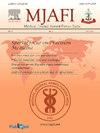A cross-sectional study of poisoning deaths by rubber latex processing acid in Tripura, India
Q2 Medicine
引用次数: 0
Abstract
Background
Rubber latex processing acid poisoning is a frequently encountered phenomenon in Tripura. Formic acid is the preferred choice for coagulating rubber latex in rubber sheet manufacturing units. The objective of this study aimed to assess the epidemiological profile of poisoning deaths by rubber processing acid and to record their autopsy findings.
Methods
This was a 2-year prospective cross-sectional study of deaths by rubber processing acid ingestion, which were brought for postmortem examination in two health care institutes of Tripura. Profiles of the cases were noted from hospital records, family members, Inquest and Challan papers from police and autopsy findings. All data were entered in SPSS software version 23.0, and Pearson's correlation was used to correlate the corrosion of stomach and survival time.
Results
Of 42 cases, 30.90% were between the ages of 41 and 50 years, and the majority were rubber tappers (69.01%). Familial disharmony (52.38%) was the most common cause of acid consumption. Close proximity (within 1 km) of the rubber tapping area to the consumption spots was observed (59.52%). Overall, 97.62% of victims had corrosion of the stomach and congestion of internal organs, and the majority (66.67%) died within 24 h of consumption.
Conclusion
This study emphasises the mortality brought on by rubber latex processing formic acid in areas surrounding rubber plantation. The poisoning prevention and control can be strategised in pre-exposure and exposure levels among vulnerable population based upon Information, Education and Communication model.
印度特里普拉橡胶胶乳加工酸中毒死亡的横断面研究
在特里普拉邦,橡胶乳胶加工过程中酸中毒是一个经常遇到的现象。甲酸是胶板生产单位凝固胶乳的首选剂。本研究的目的是评估橡胶加工酸中毒死亡的流行病学概况,并记录其尸检结果。方法对在特里普拉邦两所卫生保健机构进行尸检的橡胶加工酸摄入死亡病例进行为期2年的前瞻性横断面研究。从医院记录、家属、警方的调查和查兰文件以及尸检结果中注意到案件的概况。所有数据均在SPSS 23.0软件中录入,采用Pearson相关法将胃腐蚀与生存时间进行相关性分析。结果42例患者中,年龄在41 ~ 50岁之间的占30.90%,以橡胶粘连者居多(69.01%)。家庭不和(52.38%)是最常见的致酸原因。橡胶采胶区与消费点距离较近(1 km以内)的占59.52%;总体而言,97.62%的受害者有胃腐蚀和内脏充血,大多数(66.67%)在食用后24 h内死亡。结论本研究强调了橡胶园周边地区橡胶乳加工甲酸造成的死亡率。基于信息、教育和传播模式,可以在弱势人群暴露前和暴露水平上制定中毒预防和控制策略。
本文章由计算机程序翻译,如有差异,请以英文原文为准。
求助全文
约1分钟内获得全文
求助全文
来源期刊

Medical Journal Armed Forces India
Medicine-Medicine (all)
CiteScore
3.40
自引率
0.00%
发文量
206
期刊介绍:
This journal was conceived in 1945 as the Journal of Indian Army Medical Corps. Col DR Thapar was the first Editor who published it on behalf of Lt. Gen Gordon Wilson, the then Director of Medical Services in India. Over the years the journal has achieved various milestones. Presently it is published in Vancouver style, printed on offset, and has a distribution exceeding 5000 per issue. It is published in January, April, July and October each year.
 求助内容:
求助内容: 应助结果提醒方式:
应助结果提醒方式:


